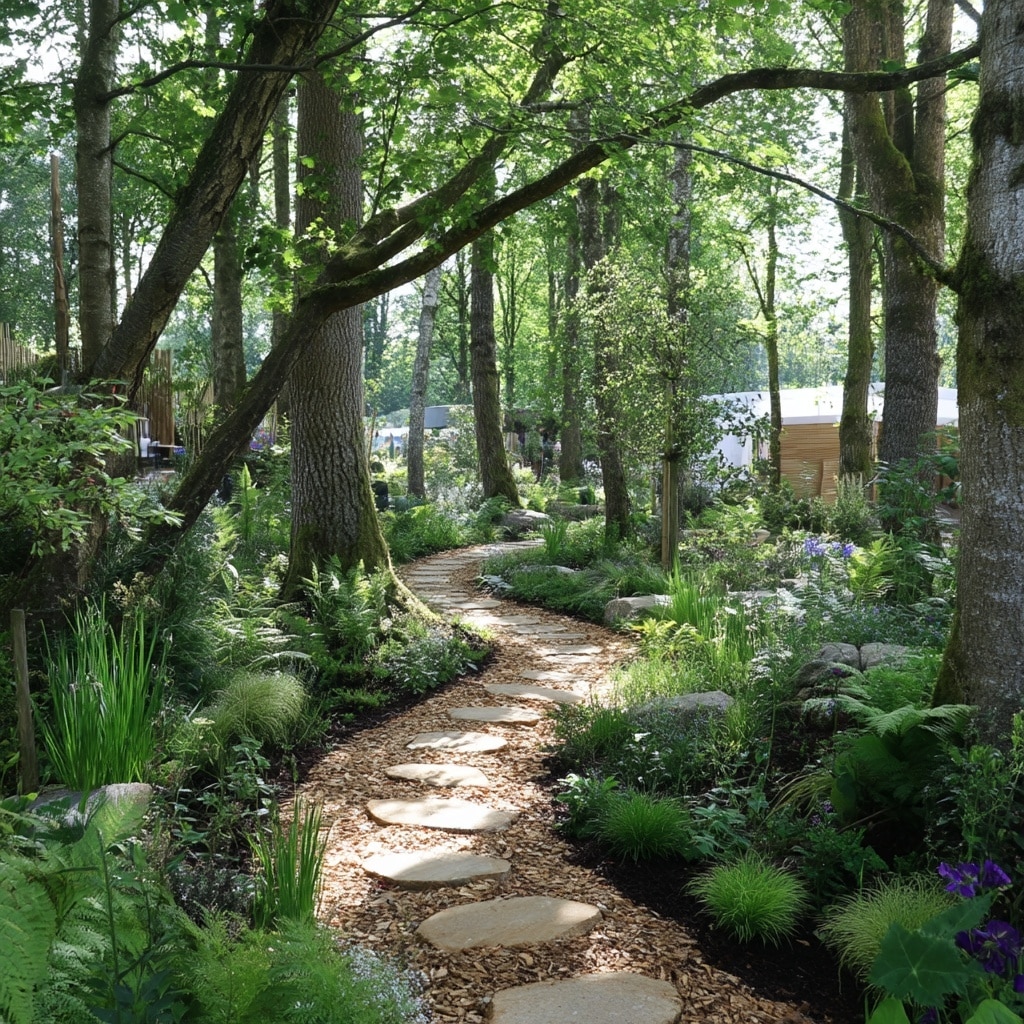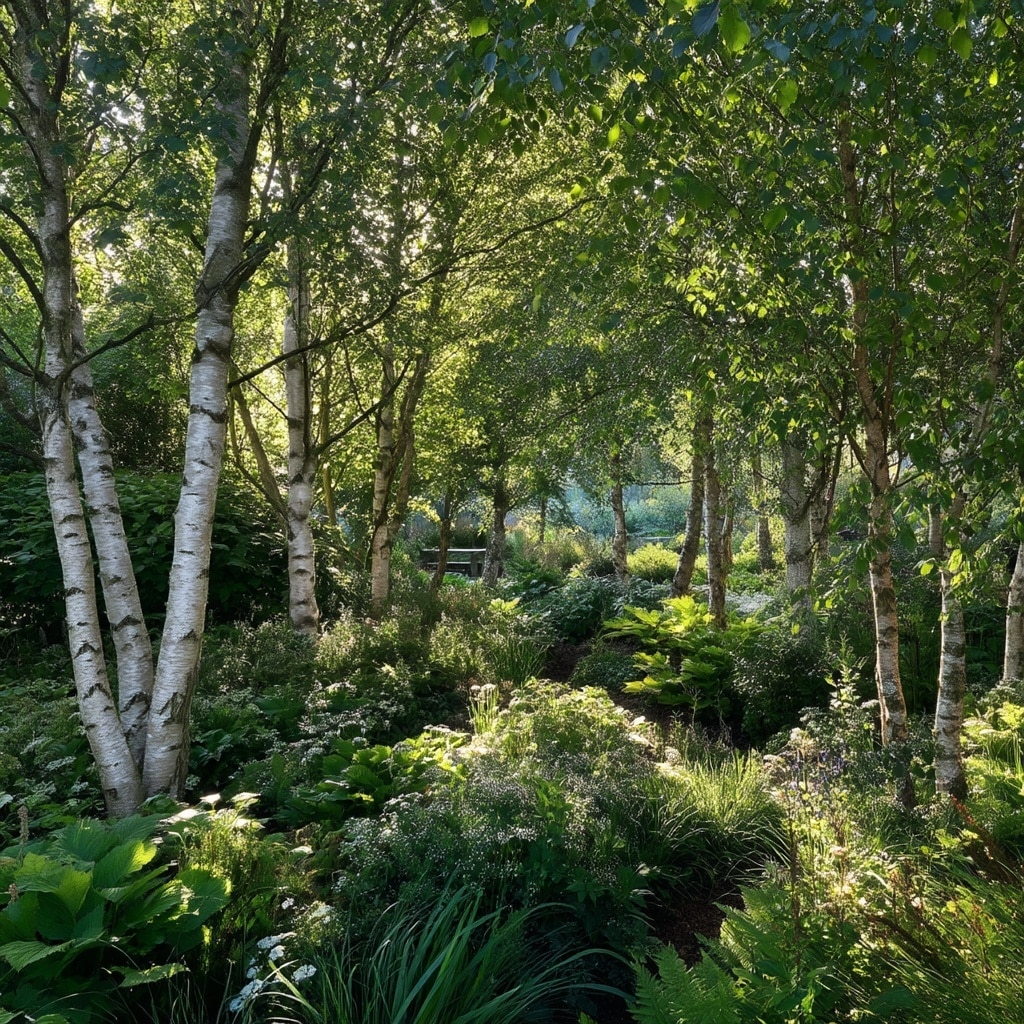Woodland garden ideas offer a magical way to bring nature’s quiet charm into your own backyard. Whether you’re starting fresh or refining an existing shaded area, this garden style transforms tree-filled corners into peaceful, biodiverse retreats. Woodland gardens don’t just look beautiful — they’re also low-maintenance, encourage native wildlife, and create cool, relaxing spaces ideal for summer afternoons.
With a thoughtful mix of trees, shrubs, ground cover, and habitat-friendly elements, these gardens mimic the layered ecosystem of a forest. The key lies in blending structure with softness—using natural materials, native plants, and a design that welcomes both people and pollinators. In this guide, we’ll walk through eight practical woodland garden ideas to help you build a space that feels wild, intentional, and wonderfully yours.
Table of Contents
1. Choose the Right Trees
The foundation of all great woodland garden ideas begins with choosing the right trees. Trees create the overhead canopy that defines a woodland garden, setting the tone for light, shade, and plant layering below.
Look for trees with light, airy canopies that allow dappled sunlight to reach the forest floor. Native species like silver birch, rowan (mountain ash), and flowering crabapple (Malus) are excellent choices. Their delicate foliage filters light beautifully while supporting local ecosystems.
Whenever possible, prioritize planting native trees suited to your region. They’re not only better adapted to local soil and weather conditions, but they also attract native birds, pollinators, and beneficial insects, enriching your garden’s biodiversity.
To keep the garden light-filled and inviting, consider crown lifting—a technique that involves removing the lower branches of mature trees. This simple pruning method increases airflow and visibility while preserving the tree’s natural beauty.
Striking the right balance between deciduous and evergreen trees is another key woodland design strategy. Deciduous trees, like oak or maple, drop leaves in autumn, naturally mulching the soil and adding nutrients. Evergreens such as pine or holly keep your garden green year-round, providing structure and visual interest even in winter.
A carefully selected tree canopy sets the stage for all the layers to come—from colorful shrubs to ground-level blooms.
2. Layer in Shrubs for Texture and Color

One of the most rewarding woodland garden ideas is adding a middle layer of shrubs to bring depth, color, and seasonal variety to your space. Positioned beneath the tree canopy, shrubs help bridge the transition between tall trees and low ground covers.
Start by mixing evergreen and deciduous shrubs. Evergreens, like boxwood or holly, provide structure and greenery year-round. Deciduous shrubs—such as oakleaf hydrangea or ninebark—change with the seasons, offering spring blooms, summer foliage, and autumn color.
For even more interest, incorporate flowering shrubs that thrive in part-shade. Rhododendrons and azaleas are woodland staples, while Virginia sweetspire and elderberry add fragrance and native appeal. Choose varieties that bloom at different times for longer-lasting color.
Foliage diversity is just as important as flowers. Shrubs like Japanese barberry, dog hobble, and ‘Silver Queen’ euonymus offer rich reds, purples, and variegated leaves that keep your garden visually dynamic, even when flowers fade.
Shrubs also play a practical role—they help define paths, soften borders, and offer shelter for birds and pollinators. By layering different heights, textures, and colors, you’ll add richness and structure to your woodland retreat.
3. Enhance the Forest Floor
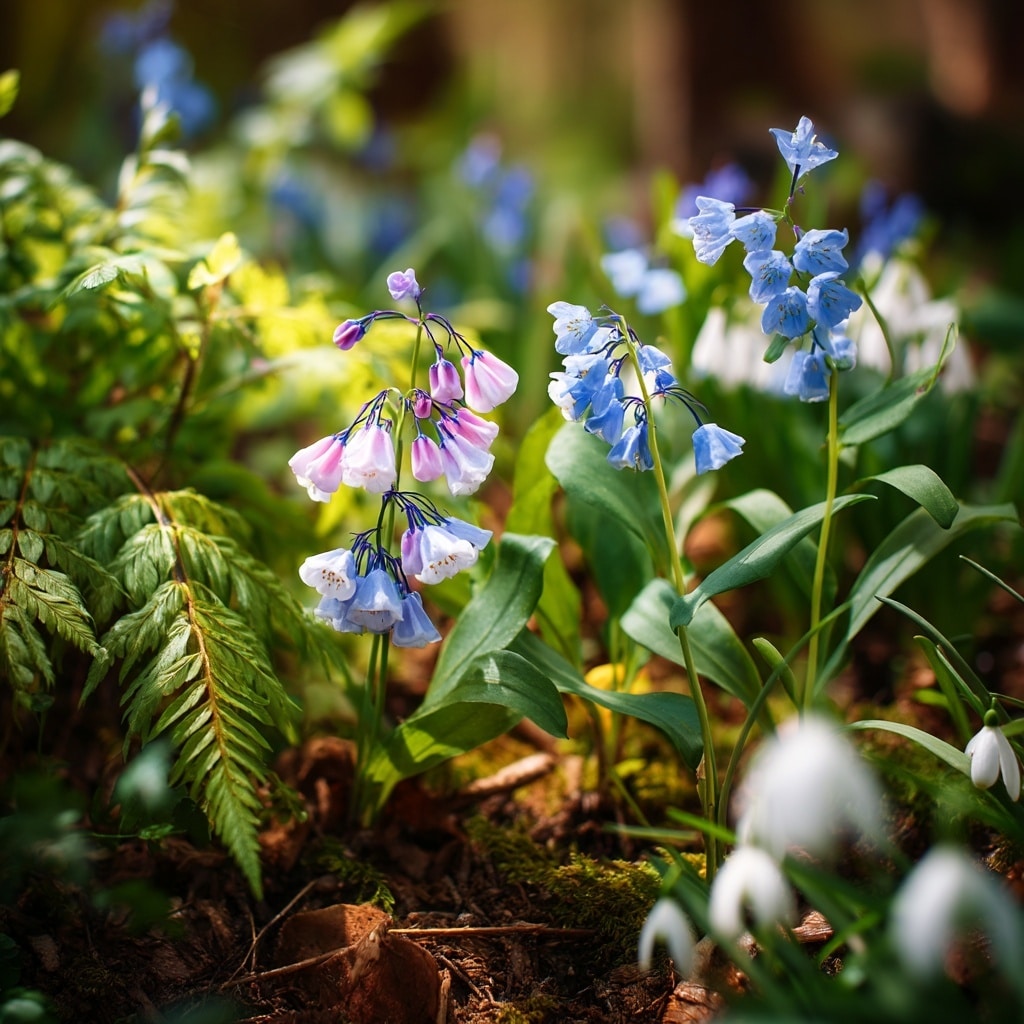
No collection of woodland garden ideas is complete without attention to the forest floor—the most intimate and magical layer of your garden. This is where the beauty of texture, color, and seasonal change truly comes alive.
Because the canopy filters light, choose shade-tolerant groundcovers and flowers that thrive in partial to full shade. Woodland plants have adapted to low-light conditions, often rewarding you with delicate, vibrant blooms.
Native wildflowers like Virginia bluebells, snowdrops, wild geranium, and Chinese ground orchid can bring spring and early summer color beneath the trees. These plants thrive in the dappled light and cooler conditions of a wooded garden.
To create soft, lush groundcover, mix in shade-loving ferns. Options like lady fern, Japanese-painted fern, holly fern, and southern maidenhair add a fine-textured elegance to the lower layer. Ferns not only look beautiful but also help suppress weeds and retain moisture in the soil.
Mulching with natural leaf litter or bark chips mimics the forest floor and supports healthy soil structure. Allow fallen leaves to decompose naturally where possible—they’ll feed the soil and protect the roots of nearby plants.
Creating a rich and varied forest floor brings the whole woodland environment together, completing the layered effect and inviting visitors to slow down and notice the small, quiet beauty underfoot.
4. Embrace Dense, Diverse Planting
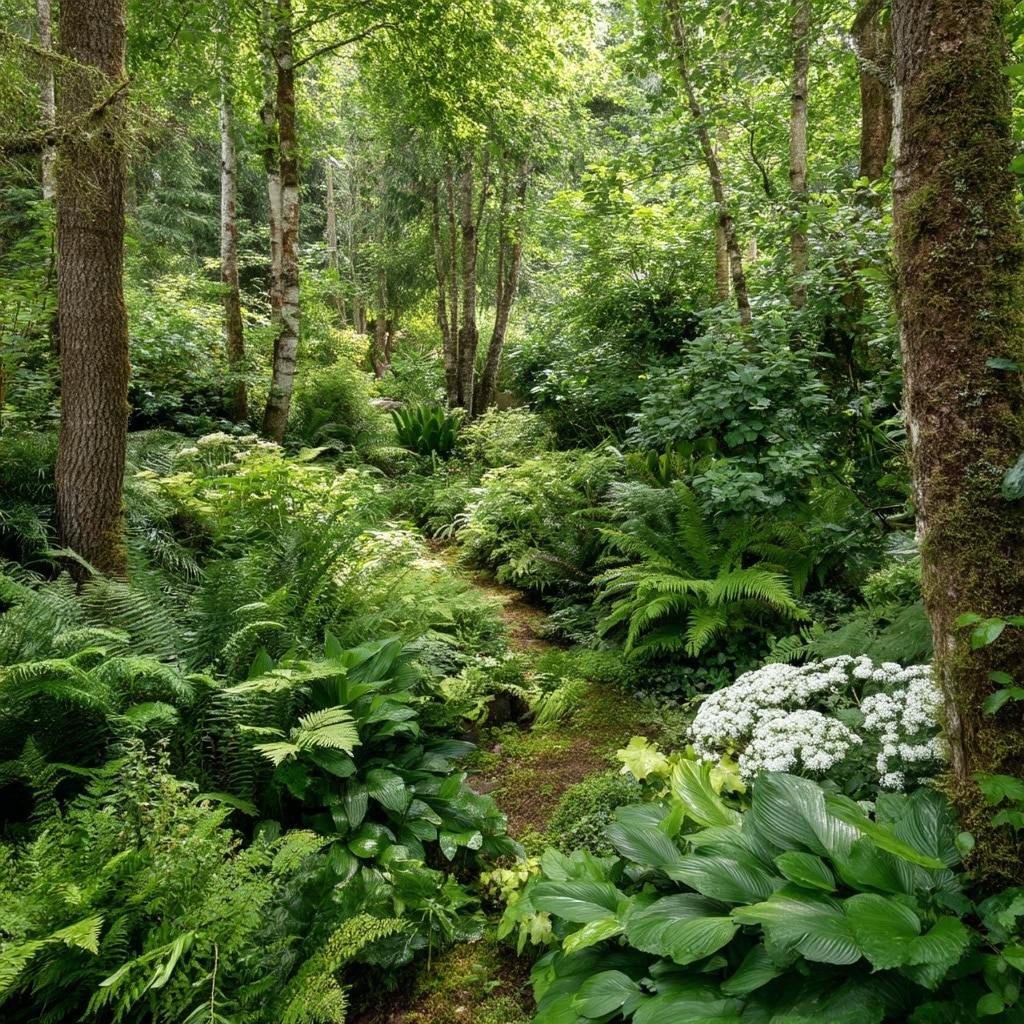
Among the smartest woodland garden ideas is cultivating a dense, diverse plant community. This layered planting style mirrors nature, where a wide range of species grow close together—improving health, beauty, and ecological balance.
Diversity isn’t just about aesthetics. Mixing different types of plants—trees, shrubs, perennials, groundcovers—creates natural resistance to pests and diseases. Many common garden problems target specific plant species, so a varied planting plan reduces the chance of widespread damage.
Dense planting also prevents weed growth by covering the soil and reducing bare patches. Plants compete with weeds for light, space, and nutrients, keeping your garden looking neat with less maintenance.
You can further strengthen your garden’s health through companion planting. Certain plants benefit one another by improving soil quality, repelling pests, or enhancing growth. For example, native grasses can stabilize soil near shrubs, while early bloomers can attract pollinators that help surrounding plants thrive.
Lastly, a well-planted woodland garden limits dominance. By spacing plants appropriately and combining fast and slow growers, you ensure no single species overtakes the rest. This balanced competition encourages healthier, more resilient growth over time.
Dense, layered planting turns your woodland garden into a living system—one that thrives on connection, balance, and natural beauty.
5. Choose Native Plants

One of the most practical and sustainable woodland garden ideas is to prioritize native plants. These species have evolved to thrive in your local climate, soil, and wildlife ecosystem—making them ideal for a low-maintenance and resilient garden.
Native plants are naturally adapted to seasonal rainfall, regional pests, and existing soil conditions. This means you’ll spend less time and effort on watering, fertilizing, and pest control. Once established, many native plants thrive with little intervention.
Beyond easy care, native species also support local biodiversity. They provide food and shelter for pollinators, birds, frogs, butterflies, and beneficial insects—creatures that help your garden flourish and contribute to a balanced environment. In fact, planting natives is one of the most effective ways to create a pollinator- and wildlife-friendly landscape.
Look for woodland natives suited to your region, such as foamflower, solomon’s seal, trillium, or columbine. These species offer a mix of textures and seasonal interest, while seamlessly blending with trees and shrubs already in your landscape.
By incorporating plants that belong in your area, you’ll create a woodland garden that feels authentic, alive, and deeply rooted in place—just as nature intended.
6. Add a Relaxing Sitting Area
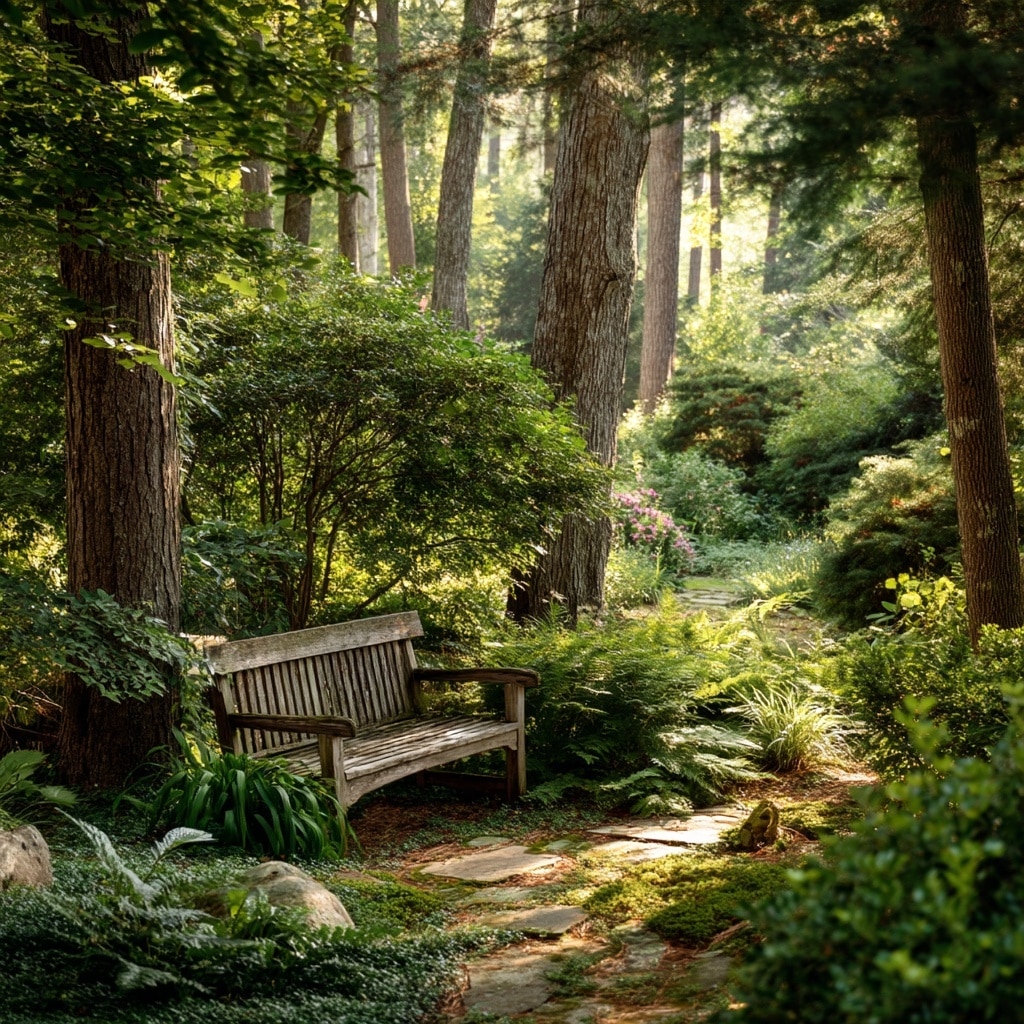
When planning woodland garden ideas, don’t forget to create a space where you can pause and enjoy the peace you’ve cultivated. A cozy sitting area allows you to experience the garden up close—surrounded by birdsong, dappled light, and the earthy scent of leaves and soil.
The shade provided by mature trees naturally cools the area beneath them. In fact, woodland gardens can be several degrees cooler than open lawns, making them perfect for escaping the summer heat. This microclimate creates a comfortable spot to unwind during hot afternoons.
You don’t need a large footprint to make an inviting rest stop. A simple bench, a stone seat tucked between shrubs, or even a hammock strung between trees can serve as your private forest retreat. If you have more space, consider a rustic table-and-chair setup for morning coffee or outdoor meals.
Choose natural materials like wood, stone, or weathered metal to keep the space in harmony with the surroundings. Tuck your seating slightly off the main path or near a favorite grouping of plants to make it feel like a hidden gem.
A thoughtfully placed sitting area turns your woodland garden into more than just a landscape—it becomes a personal sanctuary.
7. Build a Meandering Path

If you’re collecting woodland garden ideas that improve both function and beauty, a meandering path should be near the top of your list. Winding walkways not only invite exploration—they also protect your plants by guiding foot traffic away from delicate roots and groundcovers.
Paths give structure to your garden, making it feel intentional without disrupting its natural charm. The goal is to create a soft, organic flow that blends into the woodland atmosphere, rather than cutting through it.
Use natural, permeable materials such as gravel, bark chips, stepping stones, or wood slices. These materials age gracefully and allow rain to soak into the ground, supporting healthy soil and plant life. Steer clear of rigid edges; instead, let the path curve and wander between trees, shrubs, and flowering borders.
Be sure the path gives you access to all key areas—especially seating nooks, planting beds, and maintenance zones. You can also accent the edges with low-growing plants like mosses, creeping phlox, or wild violets to soften the transition between walkway and greenery.
A well-designed path turns your woodland garden into an experience—one that encourages slow walks, quiet reflection, and a deeper connection with nature.
8. Attract Birds and Bees
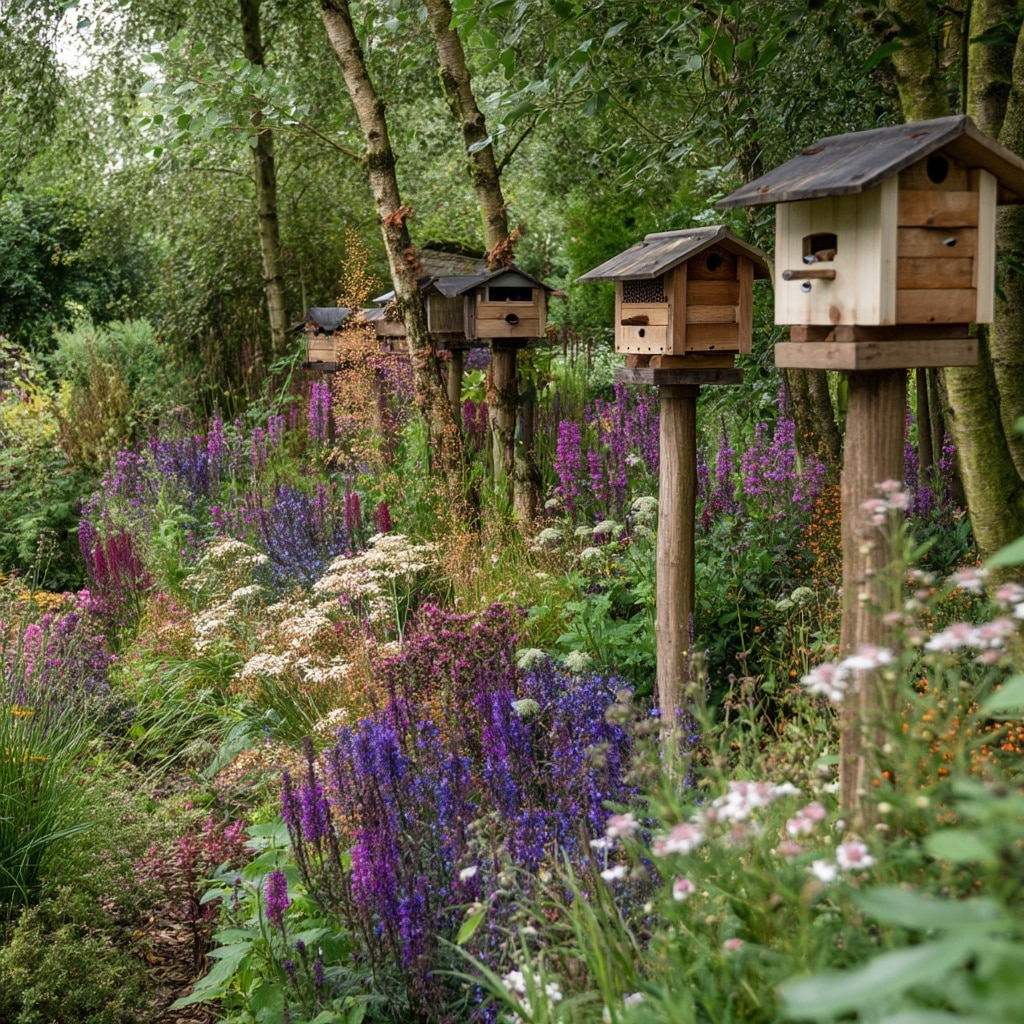
One of the most rewarding woodland garden ideas is designing your space to welcome birds, bees, and other beneficial wildlife. A biodiverse garden is not only more vibrant and alive—it’s also more balanced and resilient.
Start by adding bird nesting boxes in secluded corners of your garden. Mount them on metal poles or PVC pipe to protect against predators like raccoons or snakes. Install them before the breeding season begins—around February in warmer zones and by late March in cooler regions—to give birds time to settle in.
For pollinators, bee hotels provide a safe haven for solitary bees and wasps. These small wooden structures, filled with hollow reeds or bamboo, mimic the natural nesting cavities found in dead wood or stems. Place them in sunny, sheltered areas, ideally facing south or southeast.
You can also support pollinators by planting nectar-rich, native flowering species throughout the garden. Avoid chemical pesticides, which can harm both bees and birds. Let parts of the garden remain wild, with decaying logs or leaf litter that provide habitat for insects and small creatures.
By making space for wildlife, your woodland garden becomes a living ecosystem—buzzing, chirping, and full of quiet wonder.
A Natural Refuge in Your Backyard
As you’ve seen from these woodland garden ideas, creating a shaded, nature-rich retreat is as much about restoring balance as it is about design. By layering trees, shrubs, and groundcovers; inviting wildlife; and using native plants, your garden becomes a living, breathing forest scene—one that’s both tranquil and teeming with life.
Best of all, woodland gardens are forgiving and low-maintenance. Once established, they largely care for themselves, rewarding you with beauty through every season. Whether you’re carving out a quiet sitting area or laying a winding path, every detail contributes to a space that feels wild yet welcoming.
Start small, trust nature’s rhythm, and let your woodland garden grow with you.

